Abstract
Previous studies have noted that the prevalence of certain gonococcal colony types is influenced by the physiological state of the human host. Consequently eight different gonococcal strains were passed on clear typing medium, and opaque (Op) and transparent (Tr) variants of heavily pilated (P++) bacteria were selected. P++Op and P++Tr were injected into 11-day-old chicken embryos, and the resulting mortality was determined. In every case the Tr variants were more lethal to the embryos than were the Op variants (P = 0.01). P++Tr were stable in vivo, but chicken embryos injected with P++Op strains developed bacteremia with P++Tr organisms. However, chicken blood was not bactericidal for either colonial variant. These results indicate that transparent pilated bacteria may be more virulent than opaque pilated bacteria and that in vivo selection of transparent forms occurs.
Full text
PDF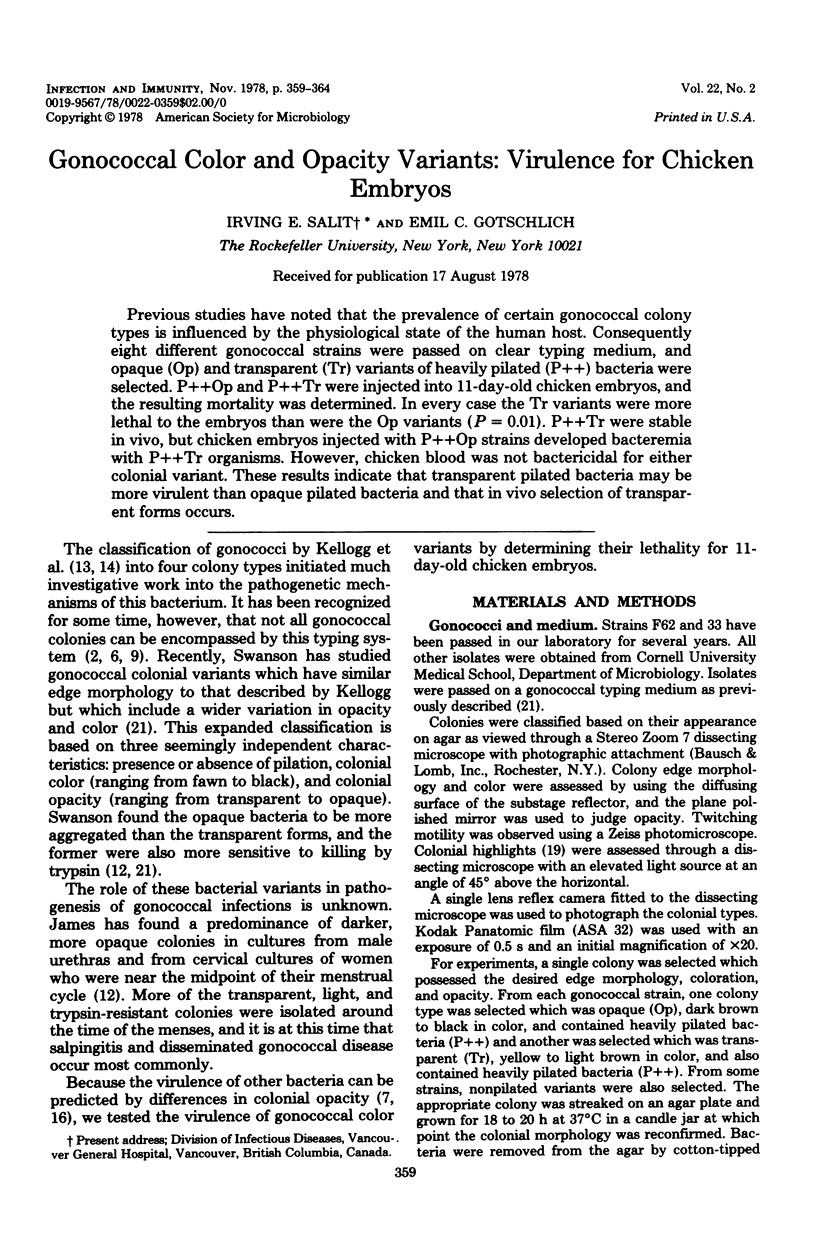
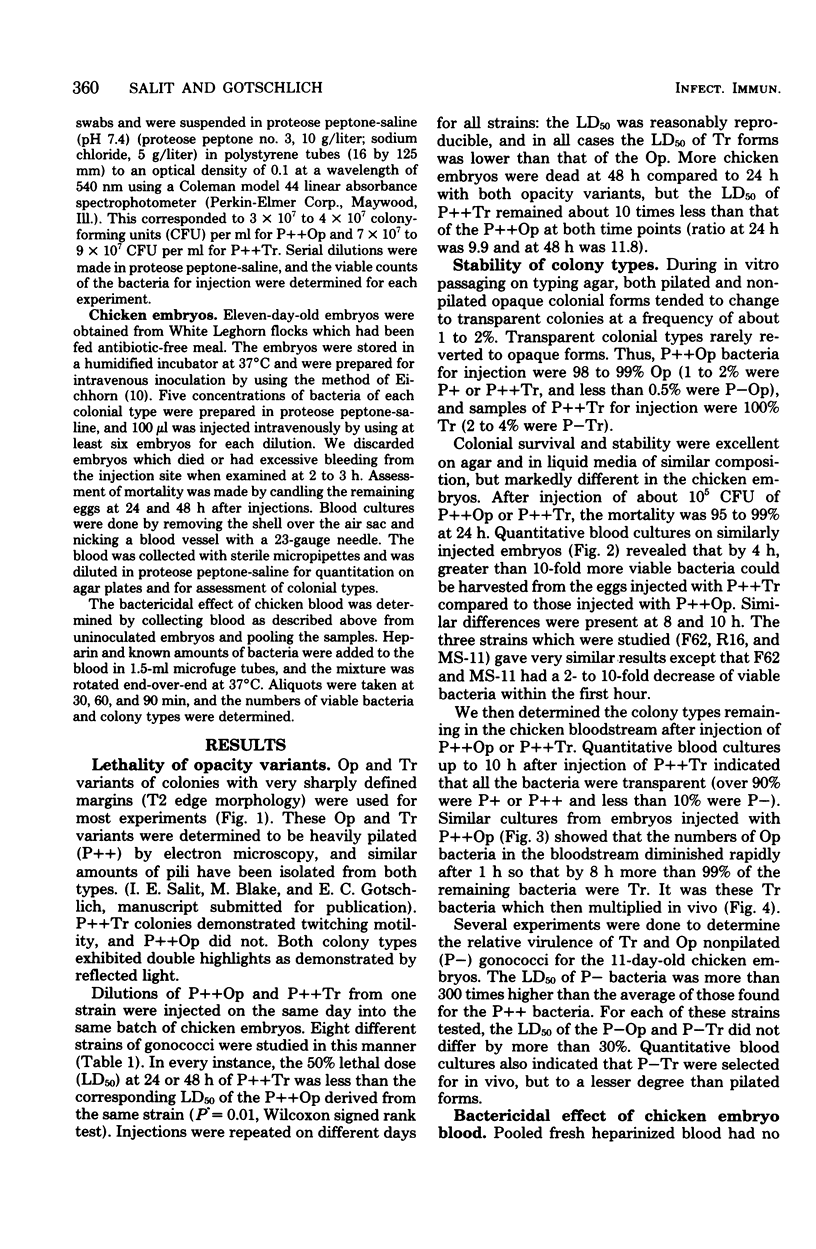
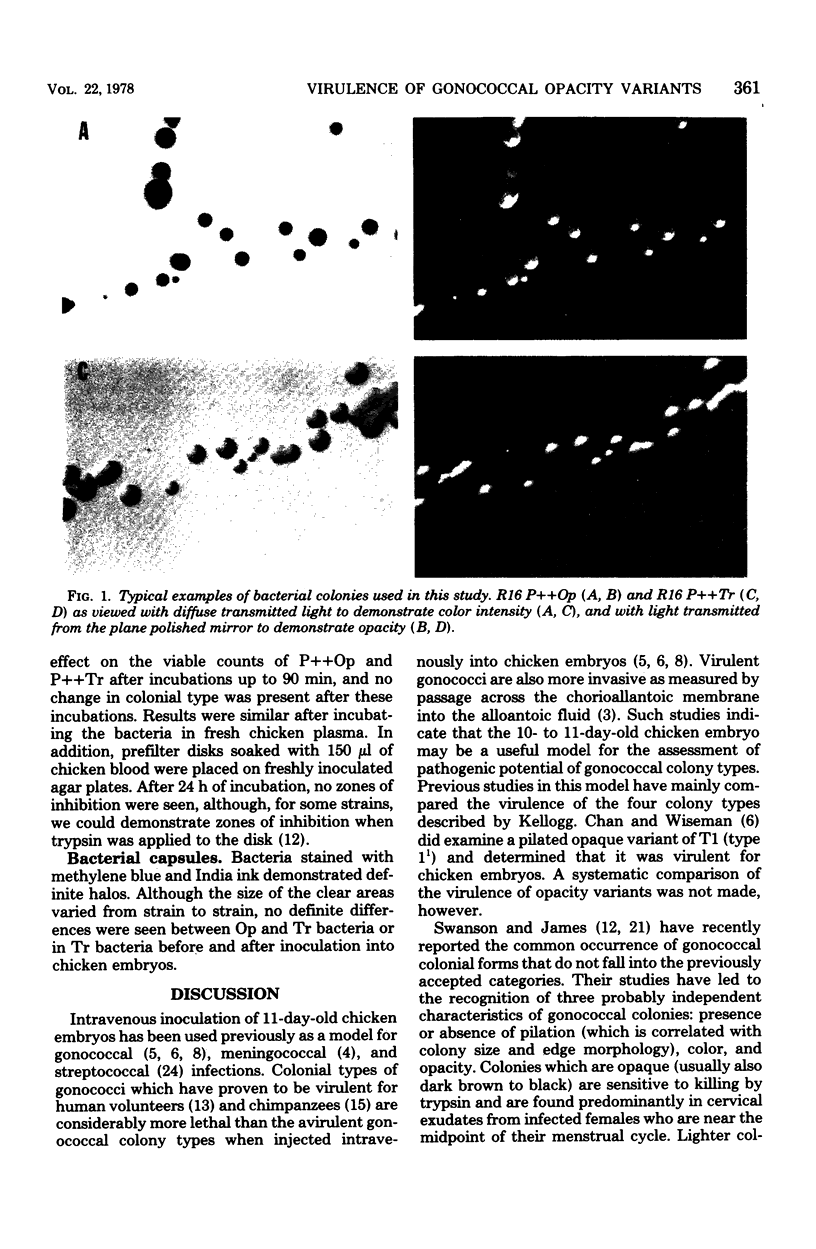
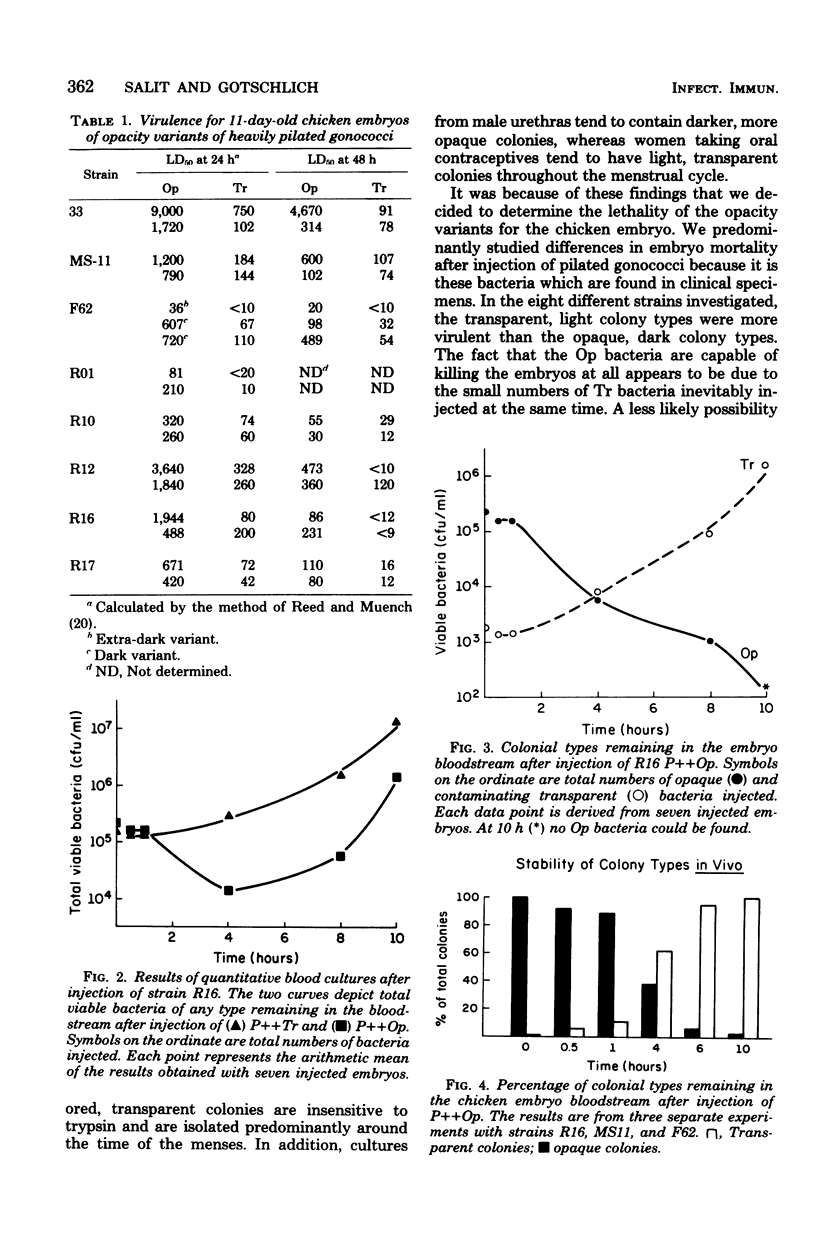
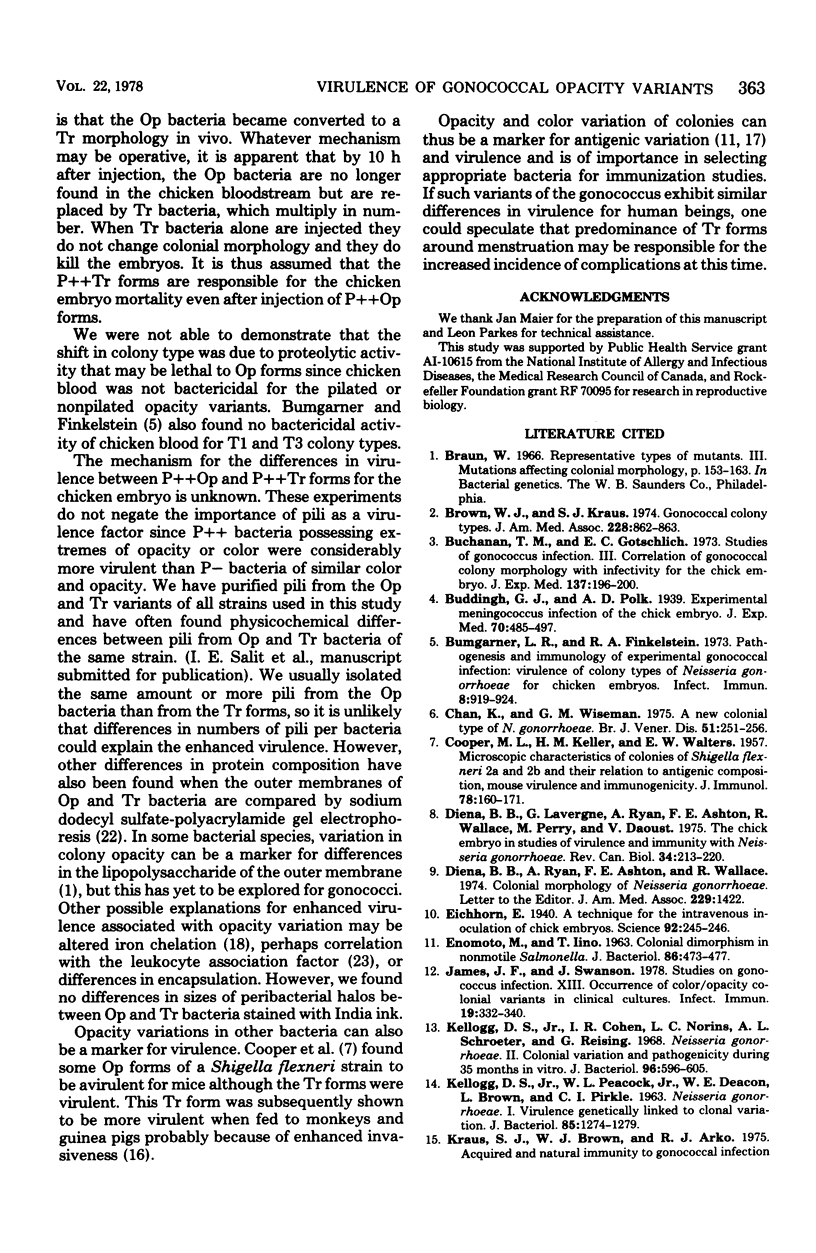
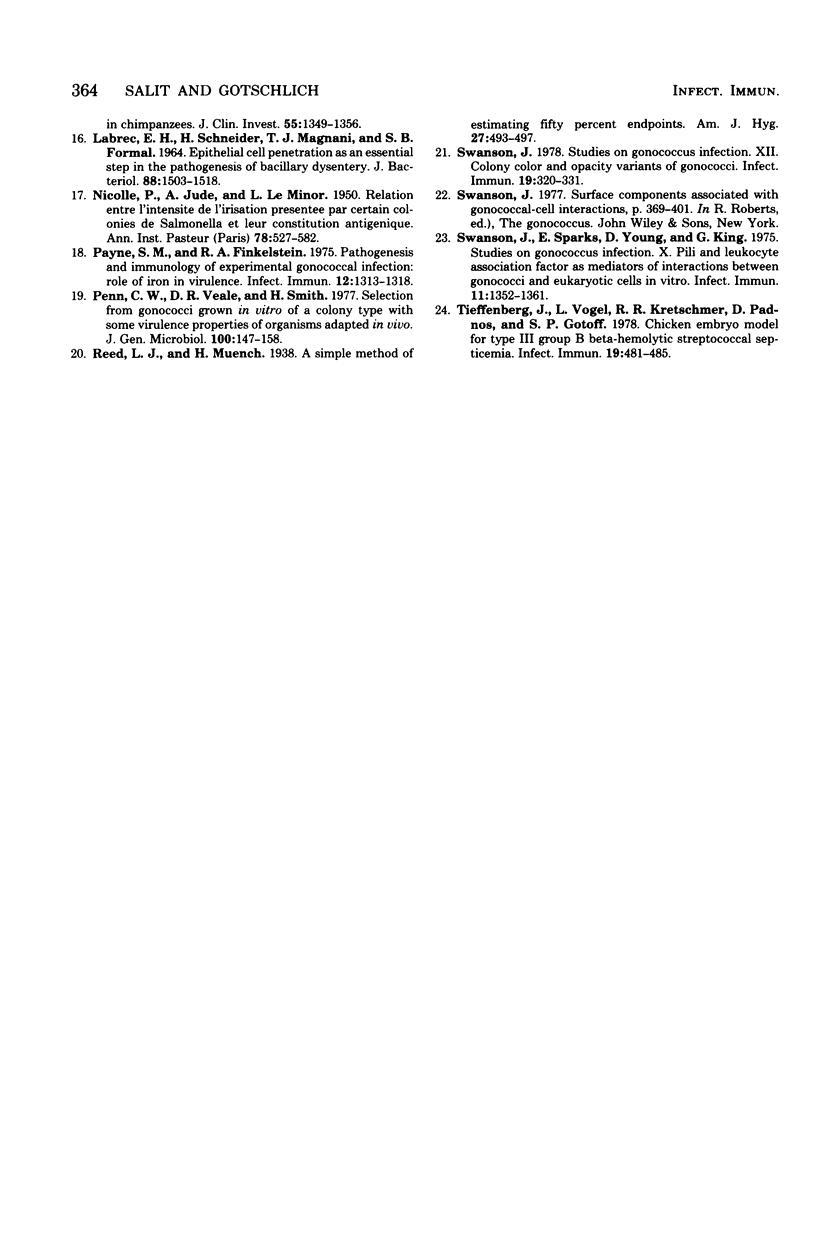
Images in this article
Selected References
These references are in PubMed. This may not be the complete list of references from this article.
- Brown W. J., Kraus S. J. Gonococcal colony types. JAMA. 1974 May 13;228(7):862–862. [PubMed] [Google Scholar]
- Buchanan T. M., Gotschlich E. C. Studies on gonococcus infection. 3. Correlation of gonococcal colony morphology with infectivity for the chick embryo. J Exp Med. 1973 Jan 1;137(1):196–200. doi: 10.1084/jem.137.1.196. [DOI] [PMC free article] [PubMed] [Google Scholar]
- Bumgarner L. R., Finkelstein R. A. Pathogenesis and immunology of experimental gonococcal infection: virulence of colony types of Neisseria gonorrhoeae for chicken embryos. Infect Immun. 1973 Dec;8(6):919–924. doi: 10.1128/iai.8.6.919-924.1973. [DOI] [PMC free article] [PubMed] [Google Scholar]
- COOPER M. L., KELLER H. M., WALTERS E. W. Microscopic characteristics of colonies of Shigella flexneri 2a and 2b and their relation to antigenic composition, mouse virulence and immunogenicity. J Immunol. 1957 Mar;78(3):160–171. [PubMed] [Google Scholar]
- Chan K., Wiseman G. M. A new colonial type of N. gonorrhoeae. Br J Vener Dis. 1975 Aug;51(4):251–256. doi: 10.1136/sti.51.4.251. [DOI] [PMC free article] [PubMed] [Google Scholar]
- Diena B. B., Lavergne G., Ryan A., Ashton F. E., Wallace R., Perry M., Daoust V. The chick embryo in studies of virulence and immunity with Neisseria Gonorrhoeae. Rev Can Biol. 1975 Dec;34(4):213–220. [PubMed] [Google Scholar]
- Diena B. B., Ryan A., Ashton F. E., Wallace R. Letter: Colonial morphology of Neisseria gonorrhoeae. JAMA. 1974 Sep 9;229(11):1422–1422. [PubMed] [Google Scholar]
- ENOMOTO M., IINO T. COLONIAL DIMORPHISM IN NONMOTILE SALMONELLA. J Bacteriol. 1963 Sep;86:473–477. doi: 10.1128/jb.86.3.473-477.1963. [DOI] [PMC free article] [PubMed] [Google Scholar]
- Eichhorn E. A. A TECHNIQUE FOR THE INTRAVENOUS INOCULATION OF CHICK EMBRYOS. Science. 1940 Sep 13;92(2385):245–246. doi: 10.1126/science.92.2385.245. [DOI] [PubMed] [Google Scholar]
- James J. F., Swanson J. Studies on gonococcus infection. XIII. Occurrence of color/opacity colonial variants in clinical cultures. Infect Immun. 1978 Jan;19(1):332–340. doi: 10.1128/iai.19.1.332-340.1978. [DOI] [PMC free article] [PubMed] [Google Scholar]
- KELLOGG D. S., Jr, PEACOCK W. L., Jr, DEACON W. E., BROWN L., PIRKLE D. I. NEISSERIA GONORRHOEAE. I. VIRULENCE GENETICALLY LINKED TO CLONAL VARIATION. J Bacteriol. 1963 Jun;85:1274–1279. doi: 10.1128/jb.85.6.1274-1279.1963. [DOI] [PMC free article] [PubMed] [Google Scholar]
- Kellogg D. S., Jr, Cohen I. R., Norins L. C., Schroeter A. L., Reising G. Neisseria gonorrhoeae. II. Colonial variation and pathogenicity during 35 months in vitro. J Bacteriol. 1968 Sep;96(3):596–605. doi: 10.1128/jb.96.3.596-605.1968. [DOI] [PMC free article] [PubMed] [Google Scholar]
- Kraus S. J., Brown W. J., Arko R. J. Acquired and natural immunity to gonococcal infection in chimpanzees. J Clin Invest. 1975 Jun;55(6):1349–1356. doi: 10.1172/JCI108054. [DOI] [PMC free article] [PubMed] [Google Scholar]
- Labrec E. H., Schneider H., Magnani T. J., Formal S. B. EPITHELIAL CELL PENETRATION AS AN ESSENTIAL STEP IN THE PATHOGENESIS OF BACILLARY DYSENTERY. J Bacteriol. 1964 Nov;88(5):1503–1518. doi: 10.1128/jb.88.5.1503-1518.1964. [DOI] [PMC free article] [PubMed] [Google Scholar]
- NICOLLE P., JUDE A., LE MINOR L. Relation entre l'intensité de l'irisation présentée par certaines colonies de Salmonella et leur constitution antigénique. Ann Inst Pasteur (Paris) 1950 May;78(5):572–582. [PubMed] [Google Scholar]
- Payne S. M., Finkelstein R. A. Pathogenesis and immunology of experimental gonococcal infection: role of iron in virulence. Infect Immun. 1975 Dec;12(6):1313–1318. doi: 10.1128/iai.12.6.1313-1318.1975. [DOI] [PMC free article] [PubMed] [Google Scholar]
- Penn C. W., Veale D. R., Smith H. Selection from gonococci grown in vitro of a colony type with some virulence properties of organisms adapted in vivo. J Gen Microbiol. 1977 May;100(1):147–158. doi: 10.1099/00221287-100-1-147. [DOI] [PubMed] [Google Scholar]
- Swanson J., Sparks E., Young D., King G. Studies on Gonococcus infection. X. Pili and leukocyte association factor as mediators of interactions between gonococci and eukaryotic cells in vitro. Infect Immun. 1975 Jun;11(6):1352–1361. doi: 10.1128/iai.11.6.1352-1361.1975. [DOI] [PMC free article] [PubMed] [Google Scholar]
- Swanson J. Studies on gonococcus infection. XII. Colony color and opacity varienats of gonococci. Infect Immun. 1978 Jan;19(1):320–331. doi: 10.1128/iai.19.1.320-331.1978. [DOI] [PMC free article] [PubMed] [Google Scholar]
- Tieffenberg J., Vogel L., Kretschmer R. R., Padnos D., Gotoff S. P. Chicken embryo model for type III group B beta-hemolytic streptococcal septicemia. Infect Immun. 1978 Feb;19(2):481–485. doi: 10.1128/iai.19.2.481-485.1978. [DOI] [PMC free article] [PubMed] [Google Scholar]



